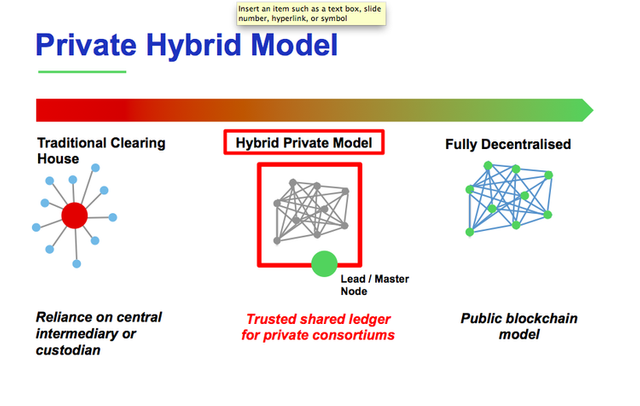"Convergence" may mean different things to different people in blockchain, but it's a word that's appearing more in more in public rhetoric of late.

For some, it simply means that innovations developed on a public blockchain powered by a cryptocurrency can be leveraged on a private blockchain used by enterprises, and vice versa. But to others, the rise of the term shows that the lines between these categories, once starkly drawn, are starting to fade.
As companies start to recognize the merits of public chains; as new technology enables different types of ledgers to communicate with each other; and as central banks consider issuing digital versions of their fiat currencies that could be used to settle trades in blockchain assets; nomenclature is evolving to fit the times.
"I would like to see in a year from now for most people to think it's absurd to say 'private networks' or 'public networks,'" John Wolpert, the former blockchain lead at IBM, said at Consensus 2018.
Back in 2015, the industry needed to diverge into public and private spheres, Wolpert said. But to him, it's becoming clear that the industry is now heading the other way.


His own CV supports this idea, as he left IBM last fall to take up the new position of "seeker of awesomeness" at ethereum design studio ConsenSys. Indeed, seeing big names from world of enterprise blockchains jump over to join startups focused on the public domain is a telling sign.
In another example, former JP Morgan blockchain lead Amber Baldet's new project, Clovyr, is all about building the middleware developer tooling and connectivity services to make convergence a reality.
There are plenty of rational reasons for people to use private networks, Baldet told CoinDesk, whether it's for added privacy, control over corporate governance, or "a computationally expensive game to get performance and cost benefits."
"As public networks gain value – it becomes where their customers are – connectivity will be an obvious evolution," she said, adding:
"Pressuring businesses to move core operations to public chains is unnecessary; soon enough the lines between public and private will blur into a pragmatic and functional internet of value."
Internet/intranet analogy
So, what does this mean in practice? Even in the highly regulated, cryptocurrency-averse world of banking, some seasoned technologists see a potential osmosis between public, open-access blockchains and private member-access networks somewhere on the horizon.
John Whelan, director of Banco Santander's Blockchain Lab, drew on the internet-intranet analogy, often used by cryptocurrency proponents to argue private blockchains will one day dissolve to insignificance.
"I think we may see – although not guaranteed – some kind of convergence between private permissioned ledger networks," said Whelan. "For private and permissioned [version], I would use the intranet analogy, and the public networks I would use as the internet analogy, with suitable bridging protocols, which are in development."
However, Whelan said the important first part of the convergence story must take place within the banks themselves: a massive reduction in the number of ledgers, duplicated technology and reconciliation.
"The financial industry is moving from an architecture of many ledgers, to one of fewer ledgers. It's that simple," he said.
Others are more skeptical about the notion of public-private convergence at the network level, but still see the two spheres influencing each other.
"On the product level, I think we can expect to see continued cross-pollination of ideas and technologies between public and private blockchains, since there is a great deal of technical overlap between these two types of system," said Gideon Greenspan, CEO of MultiChain, a startup that helps organizations build and deploy blockchains.
But the scalability, confidentiality and governance requirements are completely different for public and private chains, he added.
"I rarely, if ever, hear of a use case that could be sensibly implemented on either," said Greenspan. "The closest I've seen is using a public chain to notarize a hash representing the state of a private chain, and this can make sense for extra security, but I don't really think you can call it 'convergence.'"
Feedback loop
Of course, such views aren't stopping progress in the form of collaboration. The Enterprise Ethereum Alliance (EEA), formed in 2017 to develop standards for private forks of ethereum, has become one of the more visible convergence-seekers backed by major banks and businesses.
The group recently released a long-awaited spec, plus details of how its architecture stack dovetails with the work of the Ethereum Foundation, the nonprofit that promotes the development of the public ethereum cryptocurrency. All this has occurred under the guidance of new EEA chief Ron Resnick.
The EEA sees a positive feedback loop between features developed for enterprises and the ethereum improvement proposals (EIPs) that are floated by developers for the public network.
"As more standards are established by the EEA, I'm sure more opportunities to base standards on EIPs and vice versa will start to emerge," Conor Svensson, co-chair of the integration and tools working group at EEA, said. "I am optimistic we will see this starting to happen in 2018."
Perhaps the most prominent example of this so far has been work that Amis Technologies did with its implementation of Istanbul Byzantine Fault Tolerance for the ethereum client Go Ethereum (Geth).
This ethereum improvement proposal (EIP-650) added a new consensus algorithm to Geth, one better suited to financial enterprises than existing proof-of-work or proof of authority. And it was then added to Quorum, the private blockchain platform developed by JP Morgan.
Svensson also pointed to identity as another area where public and private chain boundaries could theoretically be crossed, since identity on a blockchain is always protected by a private key.
"As long as the private key remains secure, you have a notion of identity that can potentially be used on multiple chains (provided they use the same underlying cryptographic algorithms)," he said.
However, "whether you should use one identity across multiple chains is another question entirely," he said.
Cash on ledger
Still, a prerequisite for full-fledged convergence of public and private chains would be the development of fiat cash on distributed ledgers, or so many seem to agree.
This would allow all sorts of digital assets and blockchain-based financial instruments to flow through the systems more easily since users would trust a government-backed currency more than a volatile cryptocurrency.
"Cash on the ledger is an essential if not the essential building block for commerce on ledger platforms," said Clark Thompson, global solutions architecture lead at ConsenSys.
The ethereum-based app builder has a dedicated team of experts looking at all varieties of fiat cash on distributed ledgers, and it's working with UnionBank of the Philippines to create a low-cost tokenized fiat solution for rural banking. In time, this could be extended to cover a larger network of banks and perhaps even the central bank, ConsenSys says.
Indeed, while fiat currency held in a traditional bank account can be represented as a token on a distributed ledger, this setup creates redemption risk, which might put off some investors. The ultimate digital cash, from enterprises' point of view, would be a central bank-issued digital currency (CBDC).
"Central bank policy changes are necessary to permit central bank-issued tokenized fiat, which has the advantage that (like cash) it carries no counterparty risk," said Thomson.
It's anybody's guess how long such a change would take, though, as central banks themselves are still tentatively exploring the concept.
But Whelan at Santander (a member of the Utility Settlement Coin consortium, which is attempting to make central bank money on distributed ledgers a reality) said he believes there could be a CBDC on a distributed ledger "within a few years."
What remains to be seen is whether it is deployed directly by central banks, or uses a kind of two-step process where commercial banks essentially lend money into the system.
Whelan concluded:
"This is really a policy question for the central banks to examine. That's not a technology question."
Thank you for watching the post.
Do not forget to follow me and leave a comment below.
Hi! I am a robot. I just upvoted you! I found similar content that readers might be interested in:
http://blockchainwatchtower.com/2018/06/04/public-or-private-blockchain-distinctions-are-falling-out-of-fashion/
Downvoting a post can decrease pending rewards and make it less visible. Common reasons:
Submit